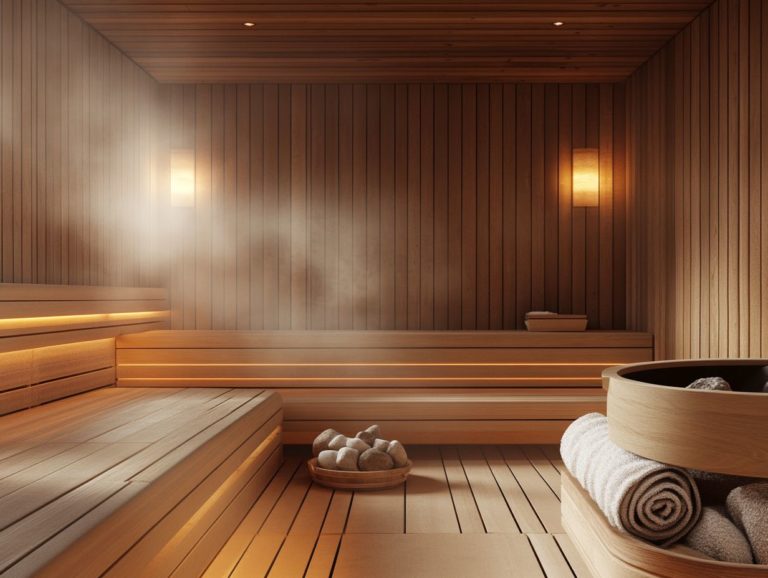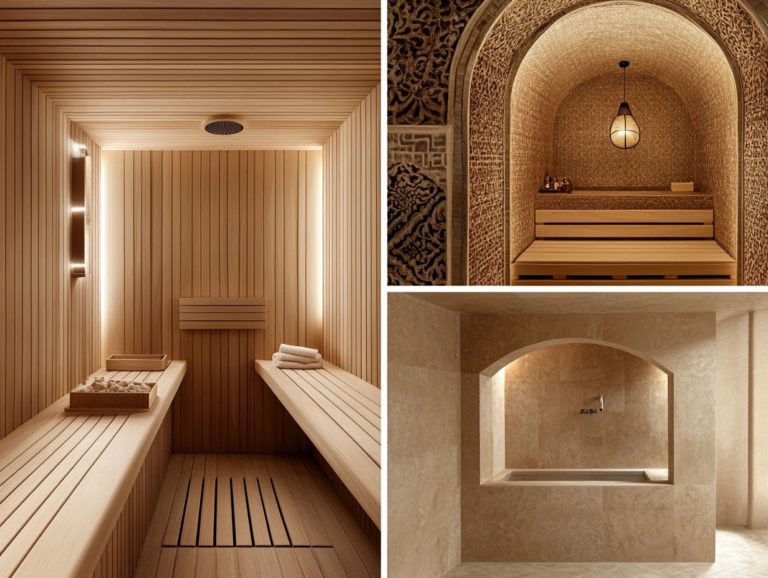The History of Saunas in Ancient Cultures
Saunas have long been revered for their soothing heat and myriad health benefits. However, their rich history often remains in the shadows.
From ancient heat therapy practices to their evolution across various civilizations, saunas weave a fascinating tapestry of cultural significance.
This exploration invites you to delve into the early forms of heat therapy. It showcases examples from diverse ancient cultures and traces the transformations in sauna design and usage over time.
You ll uncover the enduring role saunas play in society today and discover how modern saunas serve as a bridge to age-old traditions that still shape our approach to wellness.
Contents
- Key Takeaways:
- The Origins of Saunas
- Saunas in Ancient Civilizations
- The Role of Saunas in Society
- Modern Saunas and Their Roots
- Frequently Asked Questions
- 1. What is the history of saunas in ancient cultures?
- 2. How can saunas improve your mental health?
- 2. How were saunas used in ancient cultures?
- 3. What materials were used to construct saunas in ancient cultures?
- 4. How were saunas heated in ancient cultures?
- 5. Were saunas a popular practice in ancient cultures?
- 6. Are modern-day saunas similar to those used in ancient cultures?
Key Takeaways:

- Saunas have been used for heat therapy since ancient times, with early forms including hot stones and steam rooms.
- Ancient civilizations from around the world, such as the Mayans, Vikings, and Native Americans, all had their own variations of the sauna.
- Over time, saunas have evolved in design and usage, with changes in materials, heating methods, and even purposes, from health and healing to social and cultural traditions.
The Origins of Saunas
The origins of saunas can be traced back to ancient traditions in the Nordic countries. The practice of heat therapy began with early sweat baths, essential for both physical and emotional well-being.
From the humble wooden structures designed to capture the soothing warmth of fire, the sauna has transformed over centuries into a fundamental aspect of Finnish identity. It embodies self-care practices that highlight the spiritual dimensions of sauna culture.
Today, the sauna experience is a revered ritual, rich with mythology and a strong sense of communal connection.
Early Forms of Heat Therapy
Early forms of heat therapy, especially through sweat baths, have significantly influenced the evolution of sauna practices, delivering a wealth of physical and emotional benefits.
Throughout history, various cultures have recognized the restorative power of heat. From the ingenious ancient heating systems used by Romans to the soul-nourishing sweat lodges of Native Americans, these practices were crafted to induce perspiration and foster healing.
These early thermal treatments not only created communal experiences but also forged a profound connection between heat and wellness.
In your journey today, modern saunas reflect these rich traditions, providing a sanctuary for relaxation and rejuvenation.
Dive into holistic health approaches! Appreciating the evolution of these methods underscores their lasting importance in your contemporary wellness routine.
Saunas in Ancient Civilizations
Saunas have played a pivotal role in numerous ancient civilizations. The customs and traditions surrounding these heated spaces highlight their significance in social and communal settings.
Engaging in sauna rituals not only fosters a sense of belonging but also reflects the deep cultural values that have endured through time.
Examples from Different Cultures
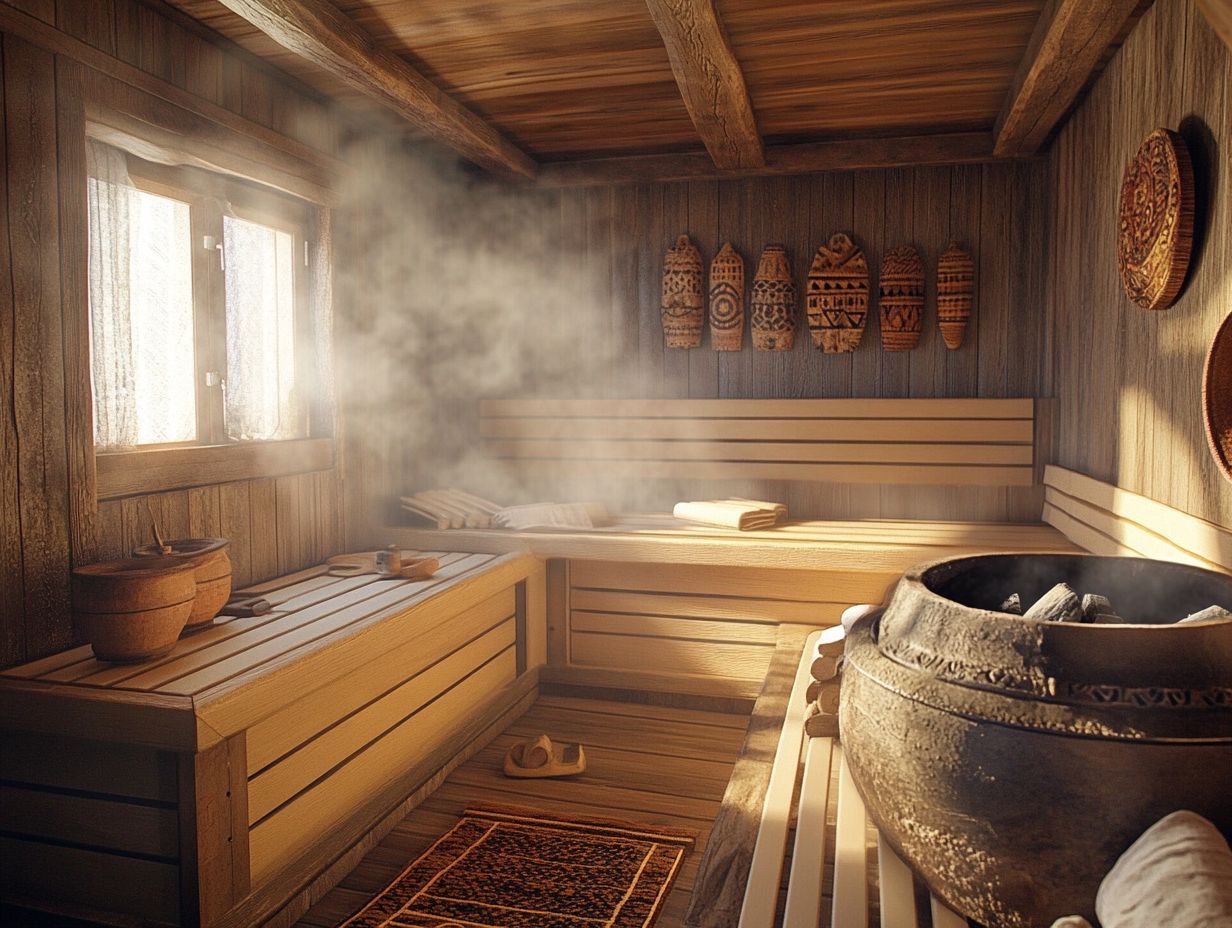
Various cultures have embraced sauna-like practices, each infusing their unique mythology and social experiences into the rich tapestry of sauna culture.
Take the S mi people of Finland, for instance. They incorporate rituals that celebrate nature and community values, often transforming the sauna into a sanctuary for reflection and bonding.
In these intimate gatherings, participants might cleanse themselves in a warm bath infused with herbs, followed by a serene moment of connection with nature.
Similarly, the Russian banyas, which are more than just places for relaxation, are vibrant social hubs. Here, the steam and birch branches create an atmosphere that nurtures both personal rejuvenation and shared experiences.
In these traditions, the sauna becomes more than a simple physical cleansing; it evolves into a spiritual journey that deepens communal ties and honors ancestral customs.
The Role of Saunas in Society
Saunas hold a crucial place in society, offering more than just a haven for physical relaxation. They serve as lively community centers where bonds are strengthened and meaningful rituals come to life.
Cultural and Social Significance
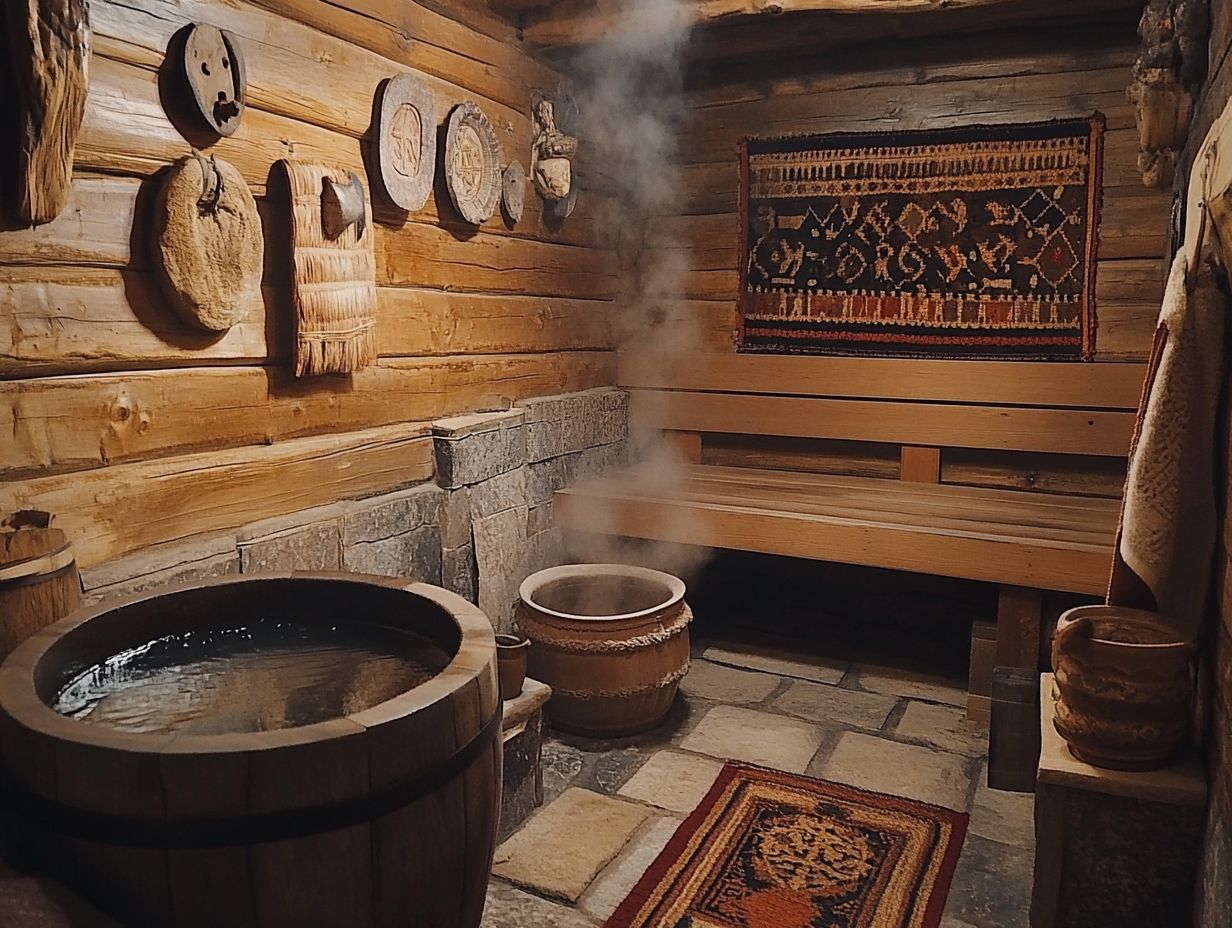
The cultural and social significance of saunas is intricately woven into sauna philosophy, highlighting wellness practices that engage both your body and spirit.
This age-old tradition is more than just a place for relaxation; it transforms into a vital space for community bonding and interpersonal connection. Embraced in various cultures, particularly in Scandinavia and parts of Eastern Europe, saunas often become sanctuaries where people gather to unwind, share stories, and foster a sense of belonging, highlighting the benefits of socializing in saunas.
These gatherings have rituals that emphasize mindfulness and emotional well-being, reflecting a collective commitment to mental health. In these warm environments, the communal experience nurtures friendships and encourages personal growth, making saunas essential to the rich tapestry of cultural identity.
Modern Saunas and Their Roots
Modern saunas, with their sleek and contemporary designs, embody a rich heritage of sauna culture. They are thoughtfully crafted to deliver substantial healing benefits through a range of therapeutic experiences.
Influences from Ancient Practices
Influences from ancient practices continue to shape your modern sauna experience, preserving the essence of rituals that have withstood the test of time.
These time-honored traditions not only foster a profound sense of cultural connection but also underscore the numerous benefits of regular sauna use, including improved relaxation, detoxification, and enhanced well-being. Gathering with others for this intimate ritual nurtures deep connections, resonating across cultures.
Today s contemporary designs often pay tribute to historical elements, ensuring that the warmth and serenity of the past continue to enrich your wellness practices.
This harmonious blend of tradition and innovation highlights the timeless allure of saunas as true sanctuaries of peace and rejuvenation.

Frequently Asked Questions
1. What is the history of saunas in ancient cultures?
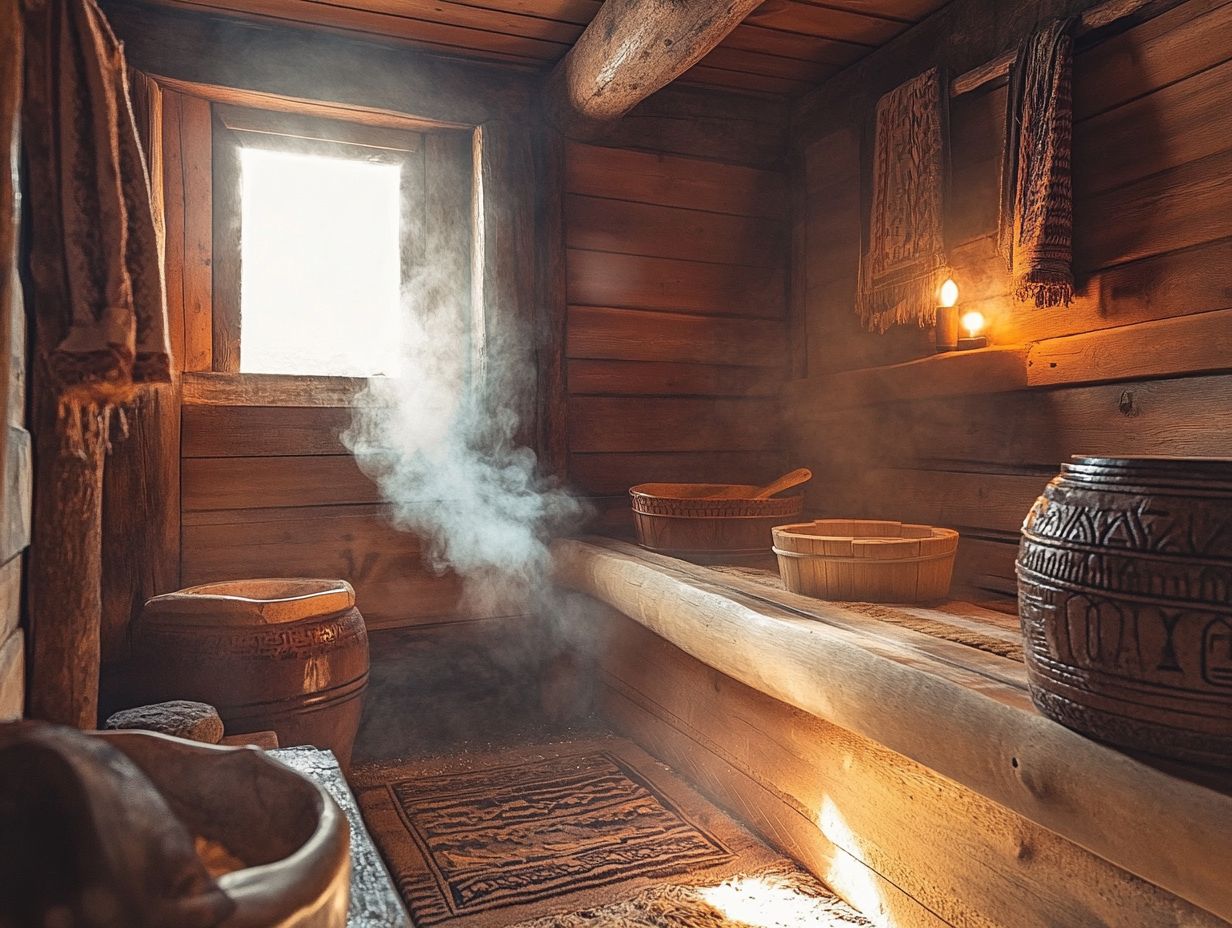
The history of saunas in ancient cultures dates back thousands of years, with evidence of their use in various civilizations such as the Egyptians, Native Americans, and ancient Romans.
2. How can saunas improve your mental health?
Saunas provide a peaceful environment that promotes relaxation, reduces stress, and fosters a sense of community, contributing positively to mental health.
2. How were saunas used in ancient cultures?
Saunas served many exciting purposes, including bathing, relaxation, healing, and spiritual rituals.
3. What materials were used to construct saunas in ancient cultures?
Saunas were often built from materials like wood, stone, and clay. The choice depended on what each civilization had available.
4. How were saunas heated in ancient cultures?
Heating was done using hot stones or fire. Pouring water over these stones created steam, making the environment hot and humid.
5. Were saunas a popular practice in ancient cultures?
Yes, many ancient cultures embraced saunas. They appeared in various forms, such as communal bathhouses, private homes, and religious ceremonies.
6. Are modern-day saunas similar to those used in ancient cultures?
The sauna experience goes beyond relaxation. It embodies a philosophy that highlights personal and collective wellness.
For further reading on the history and benefits of saunas, explore more resources!



